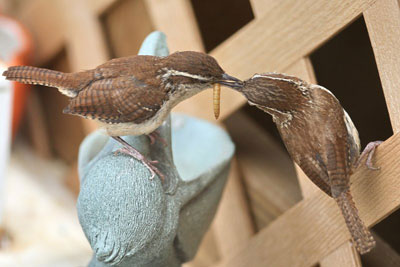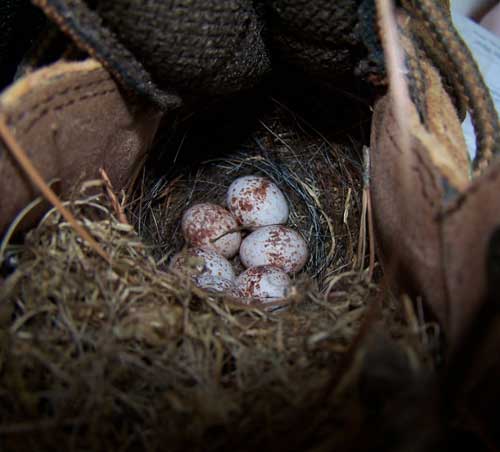Contents: Species, Interesting Facts, Identification, Song, Distribution, Preferred Nesting Habitat, Diet, Nesting Behavior, Nestboxes, Nestbox Location, Recommended Distance Between Nestboxes, Monitoring, Nesting Timetable, Longevity, More Info. Also see photos of nests, eggs and young.

Species: Four recognized subspecies – T. l. ludovicianus, T. l. miamensis, T.l. burleighi, T.l. lomitensis. Alpha code is CARW (CAWR is the Cactus Wren)
- One captive male sang 3000 songs in a single day (Simpson 1982). Males have 27-41 different songs (Erhlich et al.) Males often sing when delivering food to young.
- Build nests in bizarre locations. Males may bring in more material than females.
- Not known to destroy nests/eggs/young of other birds like the House Wren.
Identification: Small bird that flits about, with rusty upper parts, lighter cinnamon under parts with no streaking, distinctive white eye stripe (not as visible on House Wren). Long, dark, skinny recurved bill, flesh colored legs. Males and females look the same except males are usually a little chunkier (21.5 grams vs. 18.6 g for female) and have slightly longer bills, wings and legs. Quick, jerky nervous movements. May be confused with smaller, less common Bewick’s Wren (which has browner under parts, outer retrices tipped with white, and a tail that is often flipped about, and has a different song.)
Song: 2-12 syllables repeated 3-5 times. Females chatter when threatened (e.g., by humans approaching nest or other females in area .)
Distribution: Mainly eastern U.S. and Central America, common in southern U.S. Expanding northward. Cold winters with ice and snow can temporarily devastate local populations. Help them survive by feeding suet. Not migratory, but does wander.
Preferred Nesting Habitat: Dense shrub or thick underbrush, or woods with tangled brushy undergrowth. Wide range of habitats, from brushy clear cuts and lowland cypress swamps to hemlock and rhododendron choked ravines.

Diet: Mostly insects and spiders, e.g., caterpillars, bugs, beetles and beetle larvae, grasshoppers and crickets, ants, bees, wasps, craneflies, millipedes, sowbugs, snails. Occasionally lizards, frog, snake. Six% of diet vegetable matter like bayberry, sweet gum, poison ivy, sumac etc. Visits birdfeeders, loves suet.
Nesting Behavior: Pair bonds last year round or maybe even for life. Breeds first spring after being born. Appear to usually be monogamous. Males help care for nestlings and fledglings. When fighting, they usually only show aggression towards the same sex. May get kicked out by House Wren, and even Bewick’s Wren. In some areas; no interaction between Carolina and Bewick’s Wren.
Nestboxes: Prefers to nest in open cavities, may build in nooks, or unused receptacles around homes. May prefer slot boxes for nesting and roosting. Putting dried grasses in nestboxes used for roosting may help them survive cold weather. They have nested in a Peterson box, a porcelain box hanging in tree, a 4″ Gilbertson PVC nestbox, and NABS wooden boxes, and a Wood Duck nestbox.
Plans: Orthwein designed a nestbox specifically for Carolina Wrens – click here to download plans as PDF or Word document. They are easy to construct.
Nestbox Location: Carolina Wren’s may chose inconvenient places to nest in (e.g., a motorcycle helmet, a hanging plant, a folded lawnchair seat cushion, a boot) but remember that it is illegal to disturb the active nest of a native bird without a permit. May build nest in tree cavities/crotches/upturned roots, vines, conifers, roots, tree stumps, abandoned cars, garages, cofee cans, porches, rafters, shoes, helmets, shelves, mailboxes, stone walls, pockets of a coat, hanging bags, covers of propane tanks, tin cans, baskets, pails, pitchers, empty boxes, mailboxes, old hornet’s nests, paper sack, patio umbrellas, trailer hitches, covered gas grills, folded over seat cushions, sometimes in an unused cupboard or mantel shelf inside a house (entering through an open window,) etc. Nests are seldom more than 10 feet above the ground (Bent.)
Recommended distance between nestboxes: Wrens are territorial. There are not many studies of competition between Carolina, House and Bewick’s Wrens.
Monitoring: May abandon nests during construction or egg laying if disturbed (or female is captured). Some show no fear of humans when nesting in outbuildings. Adult may chatter loudly when nest area is approached. When roosting, flushed birds often return. Female may not flush when nest is monitored, unless she is touched. DO NOT OPEN BOX ON OR AFTER DAY 8 AS NESTLINGS MAY FLEDGE PREMATURELY.
- Excavation or nest site selection: May start nesting earlier when it is warmer out. Occasionally new nest built at some site of previous nest.
- Nest construction: Female chooses final site, both sexes help build nest. Males may build dummy nests in territory. Female continues to line nest cup after incubation begins. Most construction happens in the morning, in 4 – 7 days or more. Nest is a bulky, somewhat messy mass of debrislike leaves (and leaf skeletons) with some coarse hay/grass, small twigs, moss, littleroots, weed stalks; strips of bark, plastic or even snakeskin;generally domed with tunnel-like entrance; and lined withfeathers, animal hair, Spanish moss, wool, and fine grasses; sometimes paper, string, thread, wool or rags.
- Egg laying: Typically four to five eggs; set of eight recorded. One laid each day, usually within 1-2 hours of sunrise, from March through April for first brood, depending on location. Eggs are white/pale pink or rosy tint/light gray (largerthan other wren eggs); usually with heavy brown/reddish-brownflecks often heavily concentrated at larger end. Little or no gloss, unlike House Wren. See photos.
- Incubation: Begins with penultimate or last egg. Female may spend night in nest after first egg. Only female incubates, and often does not flush during monitoring.
- Hatching: In 12-14 or 16 days. Newborns are altricial, with orange-pink, translucent skin. Pale grayish down in most feather tracts. Bill is yellowish, mouth lining is red. Eggs may hatch within 10 hours of each other. Asynchronous hatching possible.
- Development: Day 0 – pigmented alar tracts. Day 1, alar sheaths emerge through skin. Day 2, tracts show pigmentation, eyes may open to small slit. Day 3 – eyes open. Day 4, spinal, ventral and femoarl tracts emerge through skin. Day 5, mother may stop brooding during day, sheaths of all tracts emerged, none ruptured. Up to days 4-5, parents eat fecal sacs, after they carry them away. Nestlings may beg until day 5-6, after that they cower. Day 6 -7 sheaths ruptured. Female may spend night in nest up to day 7 or later. Both parents feed young (female may take food from male to feed), usually one food item per trip.
- Fledging: Young hop or fly out of nest, 10-16 days after hatching (typically 12), maybe in morning. Juvenile plumage is looser and paler. Bills only 52% of adult length. Parents feed fledglings initially – male may get stuck with feeding if female starts another clutch.
- Dispersal: Not much data available, but may disappear from birthplace territory 22-37 days after fledging. At Day 34, they look like adults except bill is shorter.
- Number of broods: Two broods, up to three broods in south. Last brood eggs laid July – October, depending on location. No significant change in clutch size for different broods.
- Longevity: Oldest recaptured individual was 6 years 1 mo. old (Klimkiewicz et al 1983). Young from early nests (pre-March) can die of exposure. Major dents in populations from low temperatures, snow and ice, especially when food on ground is covered by snow and ice for extended periods. Feed suet to help survival.
References and More Information:
- Nest and Egg ID (with links to species biology and photos of nests, eggs and young) for other small cavity nesters
- Black-capped Chickadee bio
- Birds of North America online, Haggerty, Thomas M. and Eugene S. Morton. 1995. Carolina Wren (Thryothorus ludovicianus), The Birds of North America Online (A. Poole, Ed.). Ithaca: Cornell Lab of Ornithology; Retrieved from the Birds of North America Online: http://bna.birds.cornell.edu/bna/species/188 doi:10.2173/bna.188
- Life Histories of Familiar North American Birds, 1948
- The Birder’s Handbook, Erhlich et al
- Photos of nests, eggs, young, adults
- House Wren Biology and Photos
– Dr. Chapman, 1912
